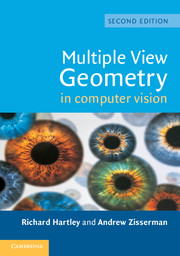Book contents
- Frontmatter
- Contents
- Foreword
- Preface
- 1 Introduction – a Tour of Multiple View Geometry
- PART 0 The Background: Projective Geometry, Transformations and Estimation
- PART I Camera Geometry and Single View Geometry
- PART II Two-View Geometry
- PART III Three-View Geometry
- PART IV N-View Geometry
- 17 N-Linearities and Multiple View Tensors
- 18 N-View Computational Methods
- 19 Auto-Calibration
- 20 Duality
- 21 Cheirality
- 22 Degenerate Configurations
- PART V Appendices
- Bibliography
- Index
19 - Auto-Calibration
Published online by Cambridge University Press: 25 January 2011
- Frontmatter
- Contents
- Foreword
- Preface
- 1 Introduction – a Tour of Multiple View Geometry
- PART 0 The Background: Projective Geometry, Transformations and Estimation
- PART I Camera Geometry and Single View Geometry
- PART II Two-View Geometry
- PART III Three-View Geometry
- PART IV N-View Geometry
- 17 N-Linearities and Multiple View Tensors
- 18 N-View Computational Methods
- 19 Auto-Calibration
- 20 Duality
- 21 Cheirality
- 22 Degenerate Configurations
- PART V Appendices
- Bibliography
- Index
Summary
Auto-calibration is the process of determining internal camera parameters directly from multiple uncalibrated images. Once this is done, it is possible to compute a metric reconstruction from the images. Auto-calibration avoids the onerous task of calibrating cameras using special calibration objects. This gives great flexibility since, for example, a camera can be calibrated directly from an image sequence despite unknown motion and changes in some of the internal parameters.
The root of the method is that a camera moves rigidly, so the absolute conic is fixed under the motion. Conversely, then, if a unique fixed conic in 3-space can be determined in some way from the images, this identifies Ω∞. As we have seen in earlier chapters, once Ω∞ is identified, the metric geometry can be computed. An array of auto-calibration methods are available for this task of identifying Ω∞.
This chapter has four main parts. First we lay out the algebraic structure of the autocalibration problem, and show how the auto-calibration equations are generated from constraints on the internal or external parameters. Second, we describe several direct methods for auto-calibration which involve computing the absolute conic or its image. These include estimating the absolute dual quadric over many views, or the Kruppa equations from view pairs. Third, are stratified methods for auto-calibration which involve two steps – first solving for the plane at infinity, then using this to solve for the absolute conic.
Information
- Type
- Chapter
- Information
- Multiple View Geometry in Computer Vision , pp. 458 - 501Publisher: Cambridge University PressPrint publication year: 2004
Accessibility standard: Unknown
Why this information is here
This section outlines the accessibility features of this content - including support for screen readers, full keyboard navigation and high-contrast display options. This may not be relevant for you.Accessibility Information
- 1
- Cited by
